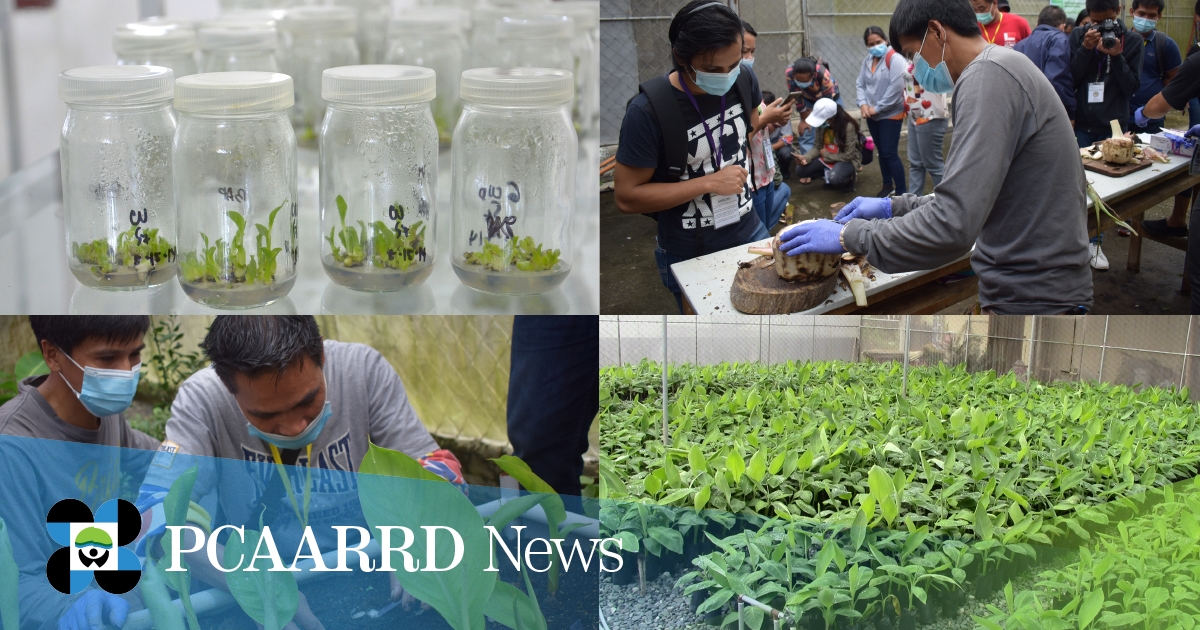Disease-free ‘Saba’ plantlets were produced through tissue culture and macropropagation technologies from existing facilities at the Nueva Vizcaya State University (NVSU), Quirino State University (QSU), and Cagayan Valley Research Center (CVRC).
The NVSU-led project, “Tissue Culture and Macropropagation of Saba: Cagayan Valley’s Planting Material Support System for Banana,” aims to address the spread of disease infection resulting from the use of infected field-grown suckers and inability of farmers to remove diseased plants immediately.
Led by Dr. Elbert A. Sana of NVSU, the project upscaled Saba plantlet production through tissue culture and whole-corm macropropagation method. These plantlets provided farmers an access to quality planting materials, which is one of the major constraints in smallhold banana production.
Disease-free Saba plantlet production
To commence the project, NVSU conducted disease indexing for the banana bunchy top virus (BBTV) and banana bract mosaic virus (BBrMV) as a critical quality control measure. This step ensured the production of disease-free planting materials before implementing macro-propagation techniques.
The three collaborating institutions employed Saba tissue culture, adhering to the standardized protocols and growth media for culture establishment, subculture, rooting, and meriplant production. Additionally, NVSU has capacitated QSU and CVRC staff on the whole corm technique and use of the Saba macropropagation in nurseries.
The project produced a total of 52,685 Saba plantlets through tissue culture (43,605 plantlets) and macropropagation (9,080 plantlets).
Farmers empowered, farms established
In collaboration with the Municipal Agriculture Offices (MAGRO) of the respective local government units, farmer cooperators were strategically selected to participate in techno-showcase and farm establishment activities. It aspires to improve cultural practices and management of Saba through demonstration farms.
The agencies established nine Saba techno-showcase farms—three from each agency located in Bayombong and Villaverde in Nueva Vizcaya; Diffun and Aglipay in Quirino; and Gamu, Mallig, and Ilagan in Isabela. Techno-showcase farms selected were given at least 100 Saba plantlets and were monitored in terms of their harvest.
A cost and return analysis conducted for a hectare of Saba plantation in Gamu, Isabela involving two production cycles (1 cycle and 1 ratoon) in 2.5 years showed a net income of P98,795 or 45.70% return on investment (ROI).
In NVSU, one of the most significant developments in these techno-showcase farms was the half-hectare expansion of a farmer cooperator’s area with 200 Saba planted.
Following the project's completion, Cagayan Valley experienced a notable increase in banana production with 85 new farmer beneficiaries establishing new banana farms across a total area of 36 hectares.
As part of the project, farmers also received a comprehensive techno-guide detailing best practices for banana management. Farmers were advised to use planting distances of 2 meters (m) x 2 m x 3 m double row planting for ‘Lakatan’ and ‘Cavendish,’ and 4 m x 4 m row planting for ‘Cardaba’ and Saba to improve production and management.
Plant maintenance including deleafing, debudding, fertilizer application, insect pest and disease management, fruit bagging, irrigation and drainage, were also recommended to farmers to boost banana production.
The said NVSU-led project is an entry for the Best Development Paper and was presented during the National Symposium on Agriculture, Aquatic and Natural Resources Research and Development (NSAARRD) held on October 2, 2024. Winners of the award will be conferred during the DOST-PCAARRD’s 2024 S&T Awards and Recognition ceremony in November 2024.
NSAARRD, annually spearheaded by DOST-PCAARRD, recognizes outstanding R&D contributions in the agriculture, aquatic, and natural resources sector in the country.

